

Literacydesign - home. A Jigsaw Lesson Strategy. Jigsaw Strategy The jigsaw lesson strategy is one where students work together as a team to learn material.
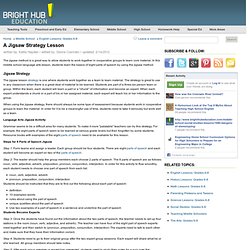
The strategy is great to use in any classroom when there is a great deal of material to be learned. Students are part of a three-six person team or group. Within the team, each student will learn a part or a "chunk" of information and become an expert. When each expert understands a chunk or a part of his or her assigned material, each expert will teach his or her information to the group. When using the jigsaw strategy, there should always be some type of assessment because students work in cooperative groups to learn the material. Language Arts Jigsaw Activity Grammar seems to be a difficult area for many students. Steps for 8 Parts of Speech Jigsaw Step 1: Form teams and assign a leader. Step 2: The leader should help the group members each choose 2 parts of speech. Noun, verb, adjective, adverb pronoun, preposition, conjunction, interjection.
Teachers Notebook.
Multiple intelligences. Welcome to Teaching That Makes Sense! Top 12 Effective End of the Year Activities. Ah, the end of the year.

Everyone’s tired and losing focus. Some tests are behind you (state tests, AP exams), some may be ahead of you, and probably no one – you or your students – is really at their best. So what’s a teacher to do? Choose a goal to make the last month of school an effective one. Here are some time-honored end of the year activities. Goal: Review What We’ve Learned You’ve got one last chance to review your material before exams (or the great mind-eraser of summer vacation). Let the kids teach the class. Split the class into groups and assign each a specific topic you studied this year.
Have students write a children’s book. When writing for younger children, your students will have to really simplify and emphasize the key elements of your course. Here's why emerging and struggling readers need technology in the classroom.
Literature Circles. 5-Minute Fillers: Comprehension, Spelling, and More. Builds listening and spelling skills Write the following headline expressions on a board or chart.
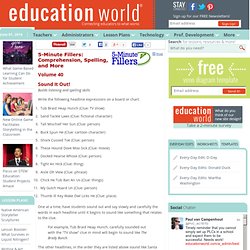
Tub Braid Heap Hunch (Clue: TV show) Sand Tackle Laws (Clue: fictional character) Tall Mischief Her Sun (Clue: person) Buck Spun He (Clue: cartoon character) Shock Cussed Toe (Clue: person) These Hound Dove Moo Sick (Clue: movie) Docked Hearse Whose (Clue: person) Tight An Hick (Clue: thing) Aisle Oh View (Clue: phrase) Chick He Tub Ban An Us (Clue: things) My Gulch Hoard Un (Clue: person) Thumb Ill Key Wake Owl Licks He (Clue: place) One at a time, have students sound out and say slowly and carefully the words in each headline until it begins to sound like something that relates to the clue.
For example, Tub Braid Heap Hunch, carefully sounded out with the "TV show" clue in mind will begin to sound like The Brady Bunch. The other headlines, in the order they are listed above sound like Santa Claus; Thomas Jefferson; Bugs Bunny; Jacques Cousteau; The Sound of Music; Dr. 5-Minute Lesson Plans. Don't Waste a Minute: Quick-Tivities for Awkward Moments. So much to do!
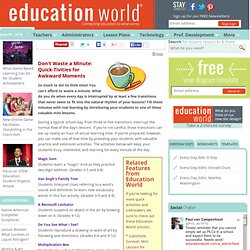
So little time! You can't afford to waste a minute. What do you do when every day is interrupted by at least a few transitions that never seem to fit into the natural rhythm of your lessons? Fill those minutes with real learning by introducing your students to one of these valuable mini lessons. During a typical school day, from three to five transitions interrupt the normal flow of the day's lessons.
Magic Sum Students learn a "magic" trick as they practice two-digit addition. Van Gogh's Family Tree Students interpret clues referring to a word's sound and definition to learn new vocabulary words in this fun activity. A Bernoulli Levitator Students suspend an object in the air by blowing down on it. Do You See What I See? Multiplication Bee Students play a fun multiplication game. I Think, Therefore... The Alphabet Game Students use a set of alphabet cards to play a small-group spelling game.
Crack the Energy Code Students solve a cryptogram and learn about fossil fuels. Back to School Lesson: Learning-Strengths Inventory. Subjects All subjects Grade [facebookbadge] Brief Description Use an online inventory to determine students' learning strengths and intelligences.
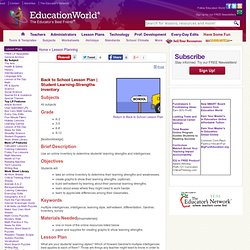
Objectives Students will take an online inventory to determine their learning strengths and weaknesses. Keywords multiple intelligences, intelligence, learning style, self-esteem, differentiation, Gardner, inventory, survey Materials Needed[shopmaterials] one or more of the online resources listed below paper and supplies for creating graphs to show learning strengths Lesson Plan What are your students' learning styles? An inventory of students' learning styles can build self-esteem by helping them discover their strengths; learn about areas in which they might need to make more effort; and appreciate the differences among themselves. Classroom Icebreaker Activities. Check out these articles on everything from preparing for the first day to dealing with homework woes, coping as a new teacher and ensuring smooth sailing for substitute teachers.
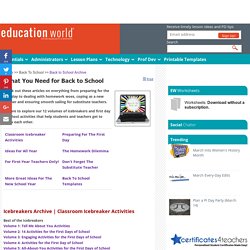
Be sure to explore our 12 volumes of icebreakers and first day of school activities that help students and teachers get to know each other. Icebreakers Archive | Classroom Icebreaker Activities. Welcome Students - Top Tips to Help Students Settle in.